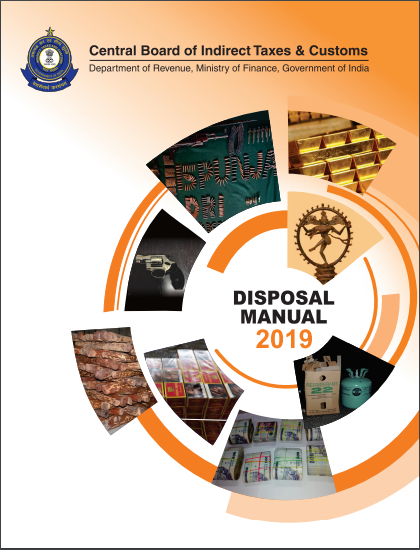Manual for disposal of seized confiscated unclaimed goods
CHAPTER – 1 Introduction
1.1. This Manual prescribes the procedures to be followed by all the field formations under the Central Board of Indirect Taxes & Customs (CBIC) for the disposal of:
i. Goods seized under the Customs Act, 1962, the Central Goods and Services Tax, 2017 (CGST Act 2017), the Integrated Goods and Services Tax, 2017 (IGST Act 2017) and the Central Excise Act, 1944;
ii. Goods confiscated under the Customs Act, 1962, the CGST Act 2017, the IGST Act 2017and the Central Excise Act, 1944;
iii. Goods uncleared/ unclaimed after importation into India and lying in the Customs Area;
iv. Mishandled Baggage;
v. Goods that involve Time-Expired Bonds; and
vi Goods detained under Section 142 of the Customs Act, 1962.
1.2. The procedures prescribed in this Manual are based on the provisions of the Customs Act, 1962, the Central Excise Act, 1944, the CGST Act 2017, the IGST Act 2017, the Rules and Regulations made thereunder, and other Allied Acts. In case of any inconsistency between these procedures and the statutory provisions, the later shall prevail.
1.3. Whereas this Manual indicates the general procedures to be followed, the concerned Principal Commissioners/ Commissioners may make requisite changes thereto, as may be necessitated by local conditions, keeping in view the spirit of instructions contained in this Manual. These changes may be informed to the Board.
1.4. In major Custom Houses, there shall be a separate unit, called the Disposal Unit which should be entrusted with the task of taking-over all goods ripe for disposal from the custodians and dispose of the same by auction or otherwise.
CHAPTER – 2 Categories of Goods
2.1. Categories of Goods
The entire stock of seized/confiscated goods, in the custody of the Department, have been grouped under the following seven categories:
Category-I: Goods to be disposed of immediately after seizure;
Category-II: Goods falling under Section 110(1A) of the Customs Act, 1962;
Category-III: Goods to be disposed of within six months from the date of seizure or where the date of expiry is indicated, well before that date;
Category-IV: Valuables;
Category-V: Goods notified under the NDPS Act;
Category-VI: Goods that have to be disposed of by way of destruction; and
Category-VII: All other goods.
2.2. For timely disposal of the goods falling under the different categories (mentioned in the Para above), the steps, as prescribed herein, should be taken by the Commissionerates:
2.3. Category-I: Goods to be Disposed of Immediately After Seizure
2.3.1. The goods under this category have a very short shelf-life as they are either prone to rapid decay or they become outdated/ obsolete very fast. Some of these goods are liable to deterioration due to drying or humidity. Some others may require special arrangements for their preservation and storage. Some of such goods may be perishable in nature, while some others may have certain expiry date prescribed thereon. Therefore, these goods may be disposed of immediately after the seizure, after the issue of a Notice to the owners/ claimant (party) and obtaining orders from the Competent Authority. The goods falling under this category include
i. Fresh flowers;
ii. Freshfruitsandvegetables, meat, fish, poultry, eggs, and other fresh canned/unprocessed food materials;
iii. Cereals, sugar and other grocery items;
iv. Beer;
v. Medicinal herbs;
vi. Cigarettes, bidis, bidi-leaves, and tobacco;
vii. Livestock;
viii. Raw (wet and salted) hides and skins;
ix. Salt and hygroscopic substances (other than in sealed containers);
x. Petroleum products;
xi. Molasses;
xii. Newspapers and Periodicals;
xiii. Confectionery;
xiv. Menthol, Camphor, Saffron;
xv. Tea and Coffee;
xvi. Cells, batteries and rechargeable batteries; and
xvii. Lighters with gas (not having an arrangement for refilling), Lighter fuel.
2.3.2. The above list is not exhaustive. The Principal Commissioner/ Commissioner in-charge may decide any seized item to be perishable, depending upon its nature and shelf-life, if he deems that prolonged storage may result in deterioration of the goods.
2.3.3. Apart from the goods which are likely to deteriorate or perish, the seized goods for which the recurring cost of upkeep or the most likely to be incurred on the special arrangements required for storage, is disproportionately high (e.g. animals or dangerous goods) may be disposed of after observing the prescribed formalities and after due intimation to the owner or claimant about the date, time and manner of such disposal.
Download the copy:
If you already have a premium membership, Sign In.
 ConsultEase Administrator
ConsultEase Administrator
Consultant
Faridabad, India
As a Consultease Administrator, I'm responsible for the smooth administration of our portal. Reach out to me in case you need help.













